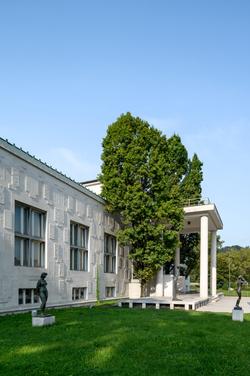Photo: Miran Kambič
Architectural Icon / Piranesi 48/49
Edvard Ravnikar: The Modern Gallery, Ljubljana, Slovenia
The Modern Gallery, a look into the future
by Patricija Pirc
The Modern Gallery in Ljubljana is the work of the architect Edvard Ravnikar, who was not a well-established architect at the time he designed it, but who had already attracted attention as a student and who, with this project, has established himself among the important architects who are key to the development of modern architecture in Slovenia.
The Modern Gallery in Ljubljana is the work of the architect Edvard Ravnikar, who was not a well-established architect at the time he designed it, but who had already attracted attention as a student and who, with this project, has established himself among the important architects who are key to the development of modern architecture in Slovenia. The Modern Gallery is not only important as a heritage building, but above all it is one of the first buildings to show strong modernist characteristics, with respect for tradition, materiality and with a look into the future.
A brief overview of the historical context will be used as a backdrop to the story of the building’s origins and, in particular, its significance for the future. The Modern Gallery was built between 1939 and 1951. The project was nearing completion when the left wing of the building was opened with a permanent exhibition of contemporary paintings. The main initiator of the gallery was Dr Izidor Cankar, who began to promote discussion on the issue as early as in 1933, since there have been no suitable venues in Slovenia at that time for exhibiting Slovenian and foreign art, with which it was important to be in contact. After much planning, designing, correspondence, the war and opposition from the profession and the public, the Modern Gallery was finally built and has remained relatively unchanged to this day.
Thus, almost a hundred years ago the bold idea was born that it was essential to support the progress of art with a suitable venue that, through a flexible design, would stimulate the development of art and, consequently, culture. In June 1940, Ravnikar also published a longer article on the Modern Gallery in the Chronicle of Slovenian Cities, in which he spoke of its educational importance; the gallery was supposed to educate audiences through lectures, films, workshops and a library, and the author emphasized that art cannot exist without an enlightened audience. He also explained his design considerations and his understanding of the project, which shows both its domesticity and its integration into the international currents of the time.[1]
[1] Edvard Ravnikar, Moderna galerija, in Kronika slovenskih mest, No. 2, June 1940.









